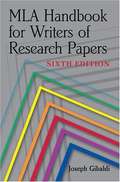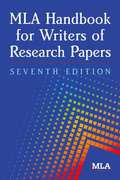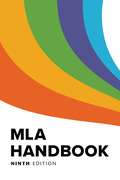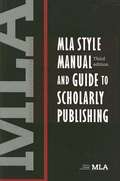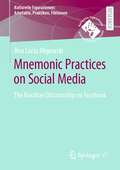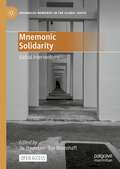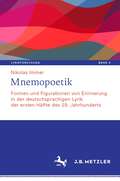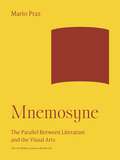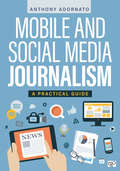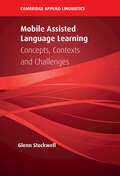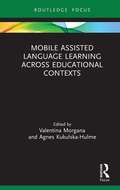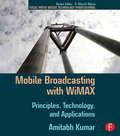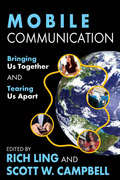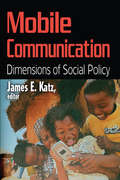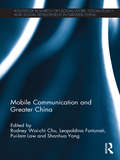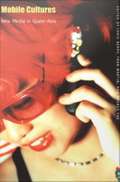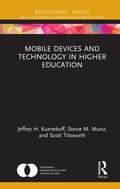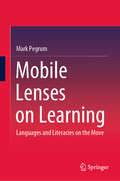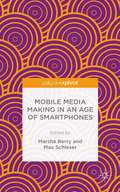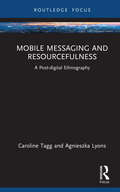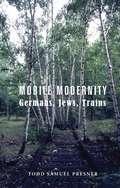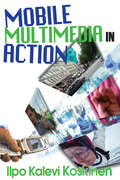- Table View
- List View
MLA Handbook for Writers of Research Papers (6th Edition)
by Joseph GibaldiThe Modern Language Association publishes two books on its documentation style: the MLA Handbook for Writers of Research Papers (for high school and undergraduate students) and the MLA Style Manual and Guide to Scholarly Publishing (for graduate students, scholars, and professional writers). These volumes provide the most accurate and complete instructions on MLA style. The publisher of this book donated a digital copy to Bookshare.org. Join us in thanking The Modern Language Association for providing this accessible digital book to this community.
MLA Handbook for Writers of Research Papers (7th edition)
by Joseph GibaldiThe seventh edition of the MLA Handbook is a comprehensive, up-to-date guide to research and writing in the online environment. It provides an authoritative update of MLA documentation style.
MLA Handbook, Ninth edition
by The Modern Language Association of AmericaRelied on by generations of writers, the MLA Handbook is published by the Modern Language Association and is the only official, authorized book on MLA style. The new, ninth edition builds on the MLA's unique approach to documenting sources using a template of core elements--facts, common to most sources, like author, title, and publication date--that allows writers to cite any type of work, from books, e-books, and journal articles in databases to song lyrics, online images, social media posts, dissertations, and more. With this focus on source evaluation as the cornerstone of citation, MLA style promotes the skills of information and digital literacy so crucial today. The many new and updated chapters make this edition the comprehensive, go-to resource for writers of research papers, and anyone citing sources, from business writers, technical writers, and freelance writers and editors to student writers and the teachers and librarians working with them. Intended for a variety of classroom contexts--middle school, high school, and college courses in composition, communication, literature, language arts, film, media studies, digital humanities, and related fields--the ninth edition of the MLA Handbook offers New chapters on grammar, punctuation, capitalization, spelling, numbers, italics, abbreviations, and principles of inclusive language Guidelines on setting up research papers in MLA format with updated advice on headings, lists, and title pages for group projects Revised, comprehensive, step-by-step instructions for creating a list of works cited in MLA format that are easier to learn and use than ever before A new appendix with hundreds of example works-cited-list entries by publication format, including websites, YouTube videos, interviews, and more Detailed examples of how to find publication information for a variety of sources Newly revised explanations of in-text citations, including comprehensive advice on how to cite multiple authors of a single work Detailed guidance on footnotes and endnotes Instructions on quoting, paraphrasing, summarizing, and avoiding plagiarism A sample essay in MLA format Annotated bibliography examples Numbered sections throughout for quick navigation Advanced tips for professional writers and scholars
MLA Style Manual and Guide to Scholarly Publishing (3rd Edition)
by The Modern Language Association of AmericaA complete, up-to-date guide for writing scholarly texts, documenting research sources, submitting manuscripts to publishers, and dealing with legal issues surrounding publication.
MLA The Easy Way
by Peggy M. Houghton Timothy J. Houghton Michele M. PrattMLA The Easy Way 8th Edition
Mnemonic Practices on Social Media: The Brazilian Dictatorship on Facebook (Kulturelle Figurationen: Artefakte, Praktiken, Fiktionen)
by Ana Lúcia Migowski da SilvaThis book reflects on discourses about the Brazilian dictatorship (1964-1985) on social media. It examines entanglements between technological and mnemonic practices regarding this historical period. Following Olick and Robbins’ (1998) Historical Sociology of Mnemonic Practices, the book analyses more than what social actors say about the past. It explores the externalisation of knowledge about the past based on interactions identified on Facebook. Through this platform, it was possible to map and collect posts, comments, and reactions related to the historical period. This sample reveals perceptions and attitudes of social media users toward the past. The book also discusses socio-technical matters grounding mnemonic practices observed on Facebook. The concept of mnemonic affordance served as a conceptual tool for understanding situational elements involved in what users perceive that they can do on Facebook while articulating meanings about the past. The close analysis of two affordances indicates specificities in the performance of mnemonic practices on Facebook. These issues shed light on struggles for legitimacy regarding memories of the dictatorship and their impact on traditional regimes of knowledge and current public affairs in Brazil.
Mnemonic Solidarity: Global Interventions (Entangled Memories in the Global South)
by Eve Rosenhaft Jie-Hyun LimThis open access book provides a concise introduction to a critical development in memory studies. A global memory formation has emerged since the 1990s, in which memories of traumatic histories in different parts of the world, often articulated in the terms established by Holocaust memory, have become entangled, reconciled, contested, conflicted and negotiated across borders. As historical actors and events across time and space become connected in new ways, new grounds for contest and competition arise; claims to the past that appeared de-territorialized in the global memory formation become re-territorialized – deployed in the service of nationalist projects. This poses challenges to scholarship but also to practice: How can we ensure that shared or comparable memories of past injustice continue to be grounds for solidarity between different memory communities? In chapters focusing on Europe, East Asia and Africa, five scholars respond to these challenges from a range of disciplinary perspectives in the humanities.
Mnemopoetik: Formen und Figurationen von Erinnerung in der deutschsprachigen Lyrik der ersten Hälfte des 19. Jahrhunderts (Lyrikforschung. Neue Arbeiten zur Theorie und Geschichte der Lyrik #4)
by Nikolas ImmerIn der ersten Hälfte des 19. Jahrhunderts avanciert die Erinnerung zu einem zentralen Gegenstand der deutschsprachigen Lyrik. Das bislang in der Forschung weitgehend marginalisierte Genre der Erinnerungslyrik wird in der vorliegenden Arbeit erstmals systematisch erschlossen. Die Untersuchung ist zum einen auf die lyrische Inszenierung von Erinnerungsakten, -orten und -objekten ausgerichtet. Zum anderen wird diskutiert, inwieweit sich insbesondere in der Geschichts-, Denkmals- und Trauerlyrik erinnerungspoetische Formationen herausbilden. Die künstlerisch anspruchsvollen und zeitreflexiven Erinnerungsgedichte August von Platens und Eduard Mörikes werden in zwei eigenständigen Fallstudien behandelt.
Mnemosyne: The Parallel Between Literature and the Visual Arts (The A. W. Mellon Lectures in the Fine Arts #16)
by Mario PrazThe classic study of the timeless relationship between literature and the visual artsIn his search for a common link between literature and the visual arts, Mario Praz draws on the abundant evidence of mutual understanding and correspondence they have long shared. Praz explains that within literature, each epoch has “its peculiar handwriting or handwritings, which, if one could interpret them, would reveal a character, even a physical appearance,” and while these characteristics belong to the general style of a given period, the personality of the writer does not fail to pierce through. Praz contends that something similar occurs in art. He shows how the likeness between the arts within various periods of history can ultimately be traced to structural similarities that arise out of the characteristic way in which the people of a certain epoch see and memorize facts aesthetically. Mnemosyne, at once the goddess of memory and the mother of the muses, presides over this view of the arts. In illustrating her influence, Praz ranges widely through Western sources, providing an incomparable tour of the literary and pictorial arts.
Mobile and Social Media Journalism: A Practical Guide
by Anthony C. AdornatoA Practical Guide for Multimedia Journalism Mobile and Social Media Journalism is the go-to guide for understanding how today&’s journalists and news organizations use mobile and social media to gather news, distribute content, and create audience engagement. Checklists and practical activities in every chapter enable readers to immediately build the mobile and social media skills that today&’s journalists need and news organizations expect. In addition to providing the fundamentals of mobile and social media journalism, award-winning communications professional and author Anthony Adornato discusses how mobile devices and social media have changed the way our audiences consume news and what that means for journalists. The book addresses a changing media landscape by emphasizing the application of the core values of journalism—such as authentication, verification, and credibility—to emerging media tools and strategies.
Mobile and Social Media Journalism: A Practical Guide
by Anthony C. AdornatoA Practical Guide for Multimedia Journalism Mobile and Social Media Journalism is the go-to guide for understanding how today’s journalists and news organizations use mobile and social media to gather news, distribute content, and create audience engagement. Checklists and practical activities in every chapter enable readers to immediately build the mobile and social media skills that today’s journalists need and news organizations expect. In addition to providing the fundamentals of mobile and social media journalism, award-winning communications professional and author Anthony Adornato discusses how mobile devices and social media have changed the way our audiences consume news and what that means for journalists. The book addresses a changing media landscape by emphasizing the application of the core values of journalism—such as authentication, verification, and credibility—to emerging media tools and strategies.
Mobile Assisted Language Learning: Concepts, Contexts and Challenges (Cambridge Applied Linguistics)
by Glenn StockwellThe increased use of sophisticated mobile devices opens up new possibilities and challenges for language teachers and learners, which has led to an increasing need to consider issues relating to mobile technologies specifically. To date, there is no comprehensive book-length treatment of issues relating to mobile-assisted language learning (MALL). This book fills that gap, providing a resource for present and future language teachers, and for graduate students of applied linguistics and TESOL, to understand how mobile devices can best be used for language teaching. It is founded on existing research, practice and theory, and offers a balanced perspective, based on the author's own experiences with mobile learning - considering the limitations of such an approach, as well as the benefits. Written in a practical and approachable tone, it provides a much-needed guide to MALL, and its fascinating insights promote further debate within the field.
Mobile Assisted Language Learning Across Educational Contexts (Routledge Focus on Applied Linguistics)
by Valentina Morgana Agnes Kukulska-HulmeThis concise collection critically reflects on mobile assisted language learning research across educational stages, from early childhood through to university settings. // The volume traces the development of MALL practices through researchers' and teachers’ efforts to make sense of the impact of mobile technologies on formal and informal second language learning and development. The chapters explore a range of topics around mobile learning design, implementation, and affordances across different educational and geographic contexts, drawing on both qualitative and quantitative perspectives. In so doing, the book creates a broader conversation around the importance of continuity in the successful integration of MALL practices into L2 learning curricula across the educational lifespan. // This book will appeal to students and scholars in applied linguistics and language teaching and learning, especially to those with a specific interest in mobile technologies.
Mobile Broadcasting with WiMAX: Principles, Technology, and Applications (Focal Press Media Technology Professional Ser.)
by Amitabh KumarWritten exclusively from broadcasters perspective, Mobile Broadcasting with WiMAX will help you move ahead in the use of WiMAX technologies. Whether you are an engineer, content provider, manager, or operator and planning such services, this book helps you understand the dimensions of this new medium and integration of communication, broadcasting and Multimedia technologies. The book oulines migrating to a new generation of broadcasting which integrates the Mobile, Wireless and Fixed network domains, then gives you a complete picture on what is happening in the field.The book is divided into five parts as follows:PART I Gives an introduction to Broadband Wireless Technologies and Mobile WiMAX. Wi-Fi including 802.11a,b,n and g, WiMAX technologies with focus on Mobile WiMAX 802.16e, and provides a global overview of deployment of Wireless broadband networks.PART-II is about Mobile Multimedia broadcasting and Mobile TV technologies, based on both cellular and broadband wireless. PART III covers Resources for Mobile multimedia broadcasting and comprises of four structured chapters on Spectrum for WiMAX networks, WiMAX terrestrial broadcasting networks, client devices for WiMAX and an update of on chipsets developments. Part IV is devoted to the Network Architectures and the integration of WiMAX with other networks, both fixed and mobile. Part V deals with Software architectures and Applications which help the process of mobile multimedia broadcasting. Case studies of prominent networks are given with country specific examples.
Mobile Communication: Bringing Us Together and Tearing Us Apart (Digital Media And Society Ser. #31)
by Scott CampbellMobile Communication covers a wide range of topics. These include the replacement of co-present interaction with mediated contact and analysis of mobile-based cohesion and gender. The authors also explore the role of media choice and its effect on the quality as well as quantity of social cohesion. Other topics include mobile communication and communities of interest; and mobile communication, cohesion, and youth.This volume brings together scholars from around the world to consider how mobile communication both builds and destroys our sense of social cohesion. There is no question that uses of technology can lead to increased cohesion within personal communities. For example, this volume includes research on caravan couples in Australia, factory workers in China, young couples in Germany, citizens in Slovenia, and sports clubs in Ireland. It also includes research on drunken calls between university students in the US, calls of international students in Switzerland and communications between immigrant women in Melbourne, Australia.However, the contributors also argue that as social networks become inundated with mobile communication users, these users may become increasingly isolated and social division can ensue.
Mobile Communication: Dimensions of Social Policy
by James E. KatzIn the few short decades since their commercial deployment, 5 billion people—about three-quarters of all humanity, including children—have become mobile phone users. No technology has even approached the mobile phone's wildfire success. Effects of this success are apparent everywhere, ranging from accident scenes and earthquake rescue efforts to demeanor in the classroom and at dinner tables. No one interested in the next generation of issues provoked by the mobile communication revolution will want to miss this important new collection of essays.The mobile phone has given near-transcendent power to ordinary people. All aspects of social life have been touched by mobile technology. An ever-growing host of tracking, immersion, gaming, and commercial applications are becoming available. The community of mobile communication scholars has blossomed from a handful of pioneers a decade ago to a large and dynamic intellectual community that spans the globe. Area researchers have gained much insight into cultural, symbolic, and social interaction aspects of mobile communication as well as its relevance to commerce.To address the social policy dimension of the mobile communication revolution, this volume presents analyses by leading thinkers in the field. The volume offers novel and keen insights into the topic. Subjects include the role of mobiles in policy formation and evaluation in several areas including the mobile-digital divide and political campaigns. Also explored are processes and policy implications of mobiles in creating or alleviating social problems including social isolation and family dispersion. Other chapters analyze social policies for mobile devices, including attempts to regulate the use of the technology and to understand and moderate its potential harm to human health. The contributors' scope ranges across five continents and they address concerns at local, national, and international levels.
Mobile Communication and Greater China (Routledge Research on Social Work, Social Policy and Social Development in Greater China)
by Rodney Wai-chi Chu Leopoldina Fortunati Pui-Lam Law Shanhua YangThis edited volume is the first book-length study focusing entirely on mobile phone use in China. Drawing on examples from a wide range of contemporary situations in China and beyond, the contributors argue that the mobile phone is in fact an important means by which one can understand a rapidly changing China, and the developing culture of mobile phone usage reflects both the cultural norms and struggle of the people. Through a theoretical comparison of usage in the West and in China, the editors assert the uniqueness of China’s experience, highlighting that Chinese society is being exposed simultaneously to a rapid process of industrialization and cyberization. The contributors maintain that such density of experience under a compressed period combined with a thick cultural heritage and a country still under a dictating rule provides a unique situation and offers deep insights into Chinese culture in general. This work will be of great interest to all students and scholars of Asian communication studies, ICT and Chinese culture and society.
Mobile Cultures: New Media in Queer Asia
by Chris Berry Fran Martin Audrey YueMobile Cultures provides much-needed, empirically grounded studies of the connections between new media technologies, the globalization of sexual cultures, and the rise of queer Asia. The availability and use of new media--fax machines, mobile phones, the Internet, electronic message boards, pagers, and global television--have grown exponentially in Asia over the past decade. This explosion of information technology has sparked a revolution, transforming lives and lifestyles, enabling the creation of communities and the expression of sexual identities in a region notorious for the regulation of both information and sexual conduct. Whether looking at the hanging of toy cartoon characters like "Hello Kitty" from mobile phones to signify queer identity in Japan or at the development of queer identities in Indonesia or Singapore, the essays collected here emphasize the enormous variance in the appeal and uses of new media from one locale to another. Scholars, artists, and activists from a range of countries, the contributors chronicle the different ways new media galvanize Asian queer communities in Taiwan, South Korea, Japan, Indonesia, Thailand, Malaysia, India, and around the world. They consider phenomena such as the uses of the Internet among gay, lesbian, or queer individuals in Taiwan and South Korea; the international popularization of Japanese queer pop culture products such as Yaoi manga; and a Thai website's reading of a scientific tract on gay genetics in light of Buddhist beliefs. Essays also explore the politically subversive possibilities opened up by the proliferation of media technologies, examining, for instance, the use of Cyberjaya--Malaysia's government-backed online portal--to form online communities in the face of strict antigay laws. Contributors. Chris Berry, Tom Boellstorff, Larissa Hjorth, Katrien Jacobs, Olivia Khoo, Fran Martin, Mark McLelland, David Mullaly, Baden Offord, Sandip Roy, Veruska Sabucco, Audrey Yue
Mobile Devices and Technology in Higher Education: Considerations for Students, Teachers, and Administrators (NCA Focus on Communication Studies)
by Jeffrey H. Kuznekoff Stevie M. Munz Scott TitsworthThis book examines key issues at the intersection of education and technology by addressing the question that most educators face—how do we use technology to engage students in the learning process and enhance learning? Problematizing the view that technology is the default solution to a host of problems facing education, while also recognizing that technology has an important place in a variety of education levels, the book provides readers with clear insights on technology and learning from a variety of perspectives from communication studies, education, and related disciplines. This volume is an essential read for scholars and teachers working in the area of elementary education. It will also be of interest to academics working in the area of education, postsecondary education, and learning and can be used as an ancillary text in graduate-level seminars.
Mobile Homes: Spatial and Cultural Negotiation in Asian American Literature (Studies In Asian Americans Ser.)
by Su-Ching HuangThe writers discussed in the book include Chiang Yee, Hualing Nieh, David Wong Louie, Fae Myenne Ng, John Okada, and Toshio Mori. Their publication dates span from the 1940s up to 2000.
Mobile Lenses on Learning: Languages and Literacies on the Move
by Mark PegrumThis book explores mobile learning as a form of learning particularly suited to our ever more mobile world, presenting a new conceptualisation of the value of mobile devices in education through the metaphor of lenses on learning. With a principal focus on mobile-assisted language learning (MALL), it draws on insights derived from MALL language, literacy and cultural projects to illustrate the possibilities inherent in all mobile learning.In its broad sweep the book takes in new and emerging technologies and tools from robots to holograms, virtual reality to augmented reality, and smart glasses to embeddable chips, considering their potential impact on education and, indeed, on human society and the planet as a whole. While not shying away from discussing the risks, it demonstrates that, handled appropriately, mobile, context-aware technologies allow educators to build on the personalised and collaborative learning facilitated by web 2.0 and social media, but simultaneously to go much further in promoting authentic learning experiences grounded in real-world encounters. In this way, teachers can better prepare students to face a global, mobile future, with all of its evolving possibilities and challenges.
Mobile Media Making in an Age of Smartphones
by Marsha Berry Max SchleserWith the rise of smartphones and the proliferation of applications ("apps"), the ways everyday media users and creative professionals represent, experience, and share the everyday is changing. With the overlay of location-based services, these experiences and representations are providing new social, creative, and emotional cartographies. This collection discusses the prospects of the proliferation of mobile and digital filmmaking opportunities, from videographic citizen journalism to networked, transmedia collaborative filmmaking and photography, and the embedding of filmmaking and photography in social media practice. The contributors reflect on emergent creative practices as well as digital ethnographies of new visualities and socialities associated with smartphone cameras in everyday life.
Mobile Messaging and Resourcefulness: A Post-Digital Ethnography (Routledge Focus on Language and Social Media)
by Caroline Tagg Agnieszka LyonsThis book advocates a new blended linguistic ethnography approach to unpacking mobile communication and enabling a more informed understanding of individuals’ communicative practices in cities today. Drawing on data from a group of ordinary working people, multilingual individuals from superdiverse cities across the United Kingdom, the volume brings observations from this data together to form a new concept of "resourcefulness" as a means of explaining the emergent sense of agency individuals develop toward remediating existing forms of technology in their everyday lives. The book in turn establishes the notion of the "networked individual" by way of demonstrating the ways in which communicative practices cross spaces and platforms. Further chapters detail examples to highlight resourcefulness at work in enabling more efficient business communication, routes to self-expression, and the creation and development of social support systems, while a concluding chapter looks at both the limitations and possibilities of resourcefulness and directions for future research. This innovative volume will be of particular interest to students and researchers in applied linguistics, sociolinguistics, linguistic ethnography, and media and communication studies.
Mobile Modernity: Germans, Jews, Trains (Cultures of History)
by Todd PresnerThough the history of the German railway system is often associated with the transportation of Jews to labor and death camps, Todd Presner looks instead to the completion of the first German railway lines and their role in remapping the cultural geography and intellectual history of Germany's Jews. Treating the German railway as both an iconic symbol of modernity and a crucial social, technological, and political force, Presner advances a groundbreaking interpretation of the ways in which mobility is inextricably linked to German and Jewish visions of modernity. Moving beyond the tired model of a failed German-Jewish dialogue, Presner emphasizes the mutual entanglement of the very categories of German and Jewish and the many sites of contact and exchange that occurred between German and Jewish thinkers.Turning to philosophy, literature, and the history of technology, and drawing on transnational cultural and diaspora studies, Presner charts the influence of increased mobility on interactions between Germans and Jews. He considers such major figures as Kafka, Heidegger, Arendt, Freud, Sebald, Hegel, and Heine, reading poetry next to philosophy, architecture next to literature, and railway maps next to cultural history. Rather than a conventional, linear history that culminates in the tragedy of the Holocaust, Presner produces a cultural mapping that articulates a much more complex story of the hopes and catastrophes of mobile modernity. By focusing on the spaces of encounter emblematically represented by the overdetermined triangulation of Germans, Jews, and trains, he introduces a new genealogy for the study of European and German-Jewish modernity.
Mobile Multimedia in Action
by Ilpo Koskinen"Mobile Multimedia in Action" displays a revealing picture of how people communicate using camera phones and other mobile multimedia devices. With such devices spreading faster than practically any other new technology, questions about how these devices are being used (and abused) to capture and distribute embarrassing or raunchy images and content, and what should be done about it, are surfacing. This volume presents the first detailed study of the use of these devices. Using a variant of social science research known as ethnomethodology, Koskinen explores the kinds of images people take with camera phones and how they use sound to enhance these images. The book asks two main questions. First, what kinds of methods of expression, such as visuals or sound, do people use when they design multimedia messages? Second, how do people interact with and respond to each other through mobile multimedia devices? Koskinen has a broader objective centering on the impact of these devices on human relationships and society at large. He asks, What do people do with these devices? Is mobile telephony moving toward a more practical direction, or will it simply become a visual chatty channel fit for gossip but not for real news or other practical purposes? What kind of social activities and organizations does it best serve - peer-to-peer networks or institutional ones? Koskinen examines these questions from three unique perspectives: the design elements of mobile multimedia, which considers methods of expression people use in designing multimedia messages; mobile multimedia as interaction, which looks into how people interact with each other using this technology and makes a case for studying multimedia as a naturally occurring activity; and mobile multimedia in society, which searches for answers as to the societal consequences of mobile multimedia usage. A groundbreaking work, "Mobile Multimedia in Action" will be a fascinating read for both multimedia device professionals and everyday users alike. Providing a glimpse into the future, Koskinen asks where mobile multimedia technology is taking mankind and society.
